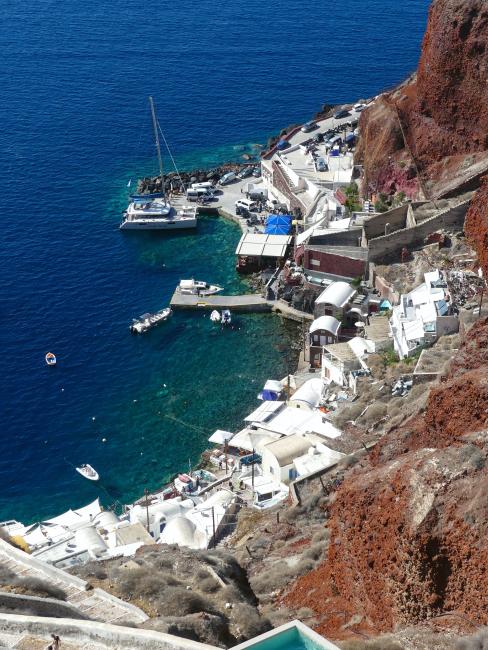
Thirasia
Thirasia or Thirasia, belongs to the island complex of Santorini (it also includes the island of the same name and Aspronisi) and is located opposite the magnificent Oia, at a distance of about one mile. Its physiognomy is mainly composed of the imposing natural relief with the impressive geological formations, the examples of unchanged folk architecture in the houses and churches, the settlement of Manolas with its authentic traditional color, the picturesque coastline of Corfu with its traditional taverns, that welcome excursionists from Santorini.
It has an area of 9,246 sq. km. and a population of 319 inhabitants during the 2011 census. According to the Kallikratis Program, it administratively belongs to the Municipality of Thira. The capital of the island is Manolas and its port is Riva.
Visitors to Thirasia are impressed by the magnificent view of Santorini, Palaia and Nea Kameni, as well as by the hospitable disposition of the residents.
Historical data
Until the Minoan eruption of the prehistoric times that created the caldera, it was part of the island of Strongyli, whose circular contour is now completed together with the islands of Thira (Santorini) and Aspronissi. Thirassia was separated from Strogyli during the catastrophic eruption of the volcano in 1600 BC.
The historian Pliny mentions that in 237 BC. Thirassia had seceded from Thera after an earthquake. Ptolemy mentions that Thirasia was a city in which important prehistoric remains of the Cycladic civilization were found and that in all historical periods it followed the fate of Thera. In 1397, the Duke of Naxos, Francesco I Crispo, is considered to have assigned it to his son Marko I together with Io.
By 1866, the mines in Therasia and Thera were in full operation as Theran land was being exported to Egypt, where the Suez Canal was being built. Some workers, randomly digging in the mine of Nikolaos Nomikos-Spyridon Alafouzou, discovered remains of an ancient building, clay vessels and a human skeleton. The doctor and MP Nikolaos Nomikos together with Alafouzos took care of the excavation of the building, while related articles were published in magazines and newspapers.
Due to the activity of the volcano in the period 1866-1870, scientists from all over the world had arrived in the area. Among them was the French volcanologist Ferdinand Fouquet, who in 1867 excavated in Therasia and studied the remains of the buildings and various other findings. The settlement in Thirasia was dated to the Late Bronze Age and these findings gave the impetus for the excavations at Akrotiri and other parts of Thira.
The settlements of Thirassia
In Manolas, the capital of Thirasia with its wonderful view of the famous caldera, the church of Agios Konstantinos and the church of Agios Ioannis are of interest.
Further on are the chapel of Prophet Ilias, on the highest peak of Thirasia, and the monastery of Panagia, on the southern tip of the island, with a unique view of the caldera, Santorini, Palaia and Nea Kameni, as well as Keradiana Gremna, an imposing location Island's.
A winding path connects Manolas with its picturesque port, Korfos. In Potamos, a Mediterranean village with a traditional color, the churches of Agios Dimitrios, Agios Spyridon and Panagia tis Yatrissa stand out. The church of Panagia toni Iisodion in Agrilia, an old rural settlement, also has excellent architecture.
At the northern end of Thirasia, opposite Amoudi of Oia, is the port of Riva.
To get to the island, one can use boats that leave from the bay of Ammoudio in Oia (a distance of about twenty minutes) or by passenger-car ferry from the port of Athens that runs routes to the port of Riva and Corfu. From the port of Piraeus there are routes to Thirasia via the line Paros - Naxos - Ios - Sikinos - Folegandros - Thirasia - Thira - Anafi.
Also, full-day sea excursions by professional pleasure boats take place every day and include, among other things, a visit to Corfos of Thirassia.